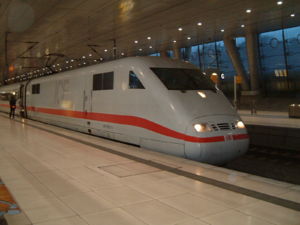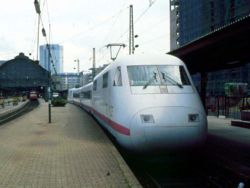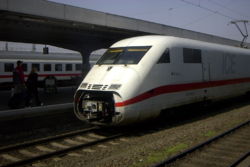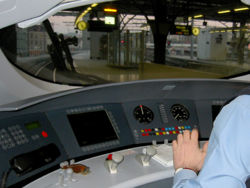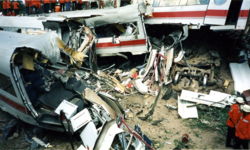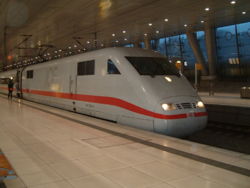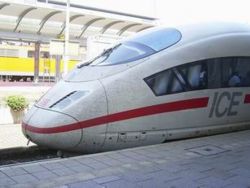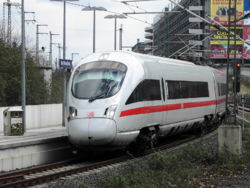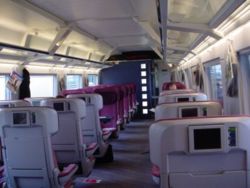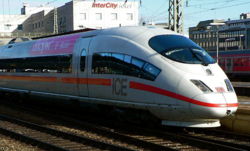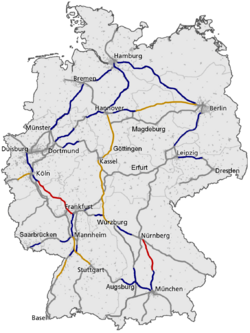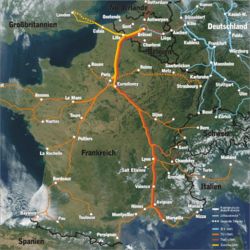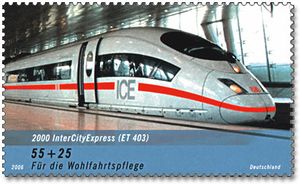InterCityExpress
The InterCityExpress or ICE (German pronunciation: [iːtseːˈeː]) is a system of high-speed trains predominantly running in Germany and its neighbouring countries. It is the highest product category of DB Fernverkehr and the flagship of Deutsche Bahn. The brand name "ICE" is among the best-known brands of Germany, with a brand awareness close to 100%, according to DB.[1]
The "ICE" name is also used for the vehicles used on the system, which were developed from the early 1980s and specifically designed for the system. There are currently three different versions of the ICE vehicles in use, named ICE 1 (deployed in 1991), ICE 2 (1996) and ICE 3 (1999). The newest incarnation, the ICE 3, is also marketed by Siemens under the Velaro name.[2]
Apart from domestic use, the trains can also be seen in Germany's neighbouring countries. There are, for example, ICE 1 and ICE 2 lines to Zürich, Switzerland or Vienna, Austria. ICE 3 trains also run to Liège and Brussels, Belgium[3] and at lower speeds to Amsterdam in the Netherlands.[4] For July 2007, a new line between Paris and Frankfurt is planned, jointly operated with ICE and Thalys trains.[5][6]
The Spanish railway operator RENFE also employs trains based on ICE 3 trains (Siemens Velaro).[7] Wider versions were ordered by China for the Beijing-Tianjin high-speed rail (CRH 3) and by Russia for the Moscow - Saint Petersburg and the Moscow - Nizhny Novgorod routes (Velaro RUS).[8]
Contents
History of the ICE
The Deutsche Bundesbahn started a series of trials in 1985 using the InterCityExperimental (also called ICE-V) test train. The IC Experimental was used as a showcase train and for high-speed trials, setting a new world speed record at 406.9 km/h (253 mph) on May 1, 1988.[9] The train was retired in 1996 and replaced with a new trial unit, called the ICE S.
After extensive discussion between the Bundesbahn and the Ministry of Transport regarding onboard equipment, length and width of the train and the number of trainsets required, a first batch of 41 units was ordered in 1988. The order was extended to 60 units in 1990, with German reunification in mind. However, not all trains could be delivered in time.
The ICE network was officially inaugurated on May 29, 1991 with several vehicles converging on the newly built station Kassel-Wilhelmshöhe from different directions.[10]
First generation
- Main article: DB Class 401
The first ICE trains were the trainsets of Class 401 (ICE 1), which had been put into service in 1989. The first regularly scheduled ICE trains ran from June 2, 1991 from Hamburg-Altona via Hamburg Hbf - Hannover Hbf - Kassel-Wilhelmshöhe - Fulda - Frankfurt Hbf - Mannheim Hbf and Stuttgart Hbf toward München Hbf on the new ICE line 6. The Hanover-Würzburg line and the Mannheim-Stuttgart line, which had both opened the same year, were hence integrated into the ICE network from the very beginning.
Due to the lack of trainsets in 1991 and early 1992, the ICE line 4 (Bremen Hbf - Hannover Hbf - Kassel-Wilhelmshöhe - Fulda - Würzburg Hbf - Nürnberg Hbf - München Hbf) could only be established on June 1, 1992. Prior to that date, ICE trainsets were used when available and were integrated in the InterCity network and with IC tariffs.
In 1993, the ICE line 6's terminus was moved from Hamburg to Berlin (later, in 1998, via the Hanover-Berlin line and the former IC line 3 from Hamburg-Altona via Hannover Hbf - Kassel-Wilhelmshöhe - Fulda - Frankfurt Hbf - Mannheim Hbf - Karlsruhe Hbf - Freiburg im Breisgau to Basel SBB was upgraded to ICE standards as a replacement.
Second generation
- Main article: DBAG Class 402
From 1997, the successor, the ICE 2 trains pulled by Class 402 powerheads, was put into service. One of the goals of the ICE 2 was to improve load balancing due to their portion working concept.
These trainsets were used on the ICE line 10 Berlin-Cologne/Bonn. However, since the driving van trailers of the trains were still pending approval, the DB joined two portions (with one powerhead each) to form a long train, similar to the ICE 1. Only from May 24, 1998 the ICE 2 units were fully equipped with driving van trailers, and could be portioned on their run from Hamm via either Dortmund Hbf - Essen Hbf - Duisburg Hbf - Düsseldorf Hbf or Hagen Hbf - Wuppertal Hbf - Solingen-Ohligs.
In late 1998, the Hanover-Berlin high-speed rail line was opened as the third high-speed line in Germany, cutting travel time on line 10 (between Berlin and the Ruhr valley by 2½ hours.
The ICE 1 and ICE 2 trains exceed the loading gauge recommended by the international railway organisation UIC. Even though the trains were originally to be used only domestically, some units are licensed to run in Switzerland and Austria. Some ICE 1 units have been equipped with an additional smaller pantograph to be able to run on the different Swiss overhead wire geometry. All ICE 1 and ICE 2 trains are single-voltage 15 kV AC, which restricts their radius of operation largely to the German-speaking countries of Europe.
Third generation
- Main article: Siemens Velaro
To overcome the restrictions imposed on the ICE 1 and ICE 2, their successor, the ICE 3, was built to a smaller loading gauge to permit usability throughout Europe. Contrary to their predecessors, the ICE 3 units are not built as a locomotive-pulled train (albeit aerodynamically optimised), but as electric multiple units with underfloor motors throughout the unit. This also reduced the load per axle and enabled the ICE 3 to fulfill the respective UIC standard.
Two different classes were developed: the Class 403 (domestic ICE 3) and the Class 406 (ICE 3M), the M standing for Mehrsystem (multi-voltage). The trains were labelled and marketed as the Velaro by their manufacturer, Siemens.
Just like the ICE 2, the ICE 3 and the ICE 3M were developed as half-length trains (when compared to an ICE 1) and are able to travel in portions, with individual units running on different lines, then coupling automatically to travel together. Since the ICE 3 trains are the only ones able to run on the Cologne-Frankfurt high-speed line with its 40 ‰ incline, they are predominantly used on services that utilise this line.
Deutsche Bahn is planning to order another 30 units - worth € 900 million - for international traffic, especially to France.
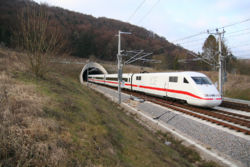
The newest high-speed line in Germany, the Nuremberg-Ingolstadt high-speed rail line, which opened in May 2006, has been the most recent addition to the ICE network. It is one of two lines in Germany (among with the Cologne to Frankfurt line) that is equipped for line speeds up to 300 km/h. Since only 3rd generation ICE trains are capable of such speeds, the ICE line 41, formerly running from Essen Hbf via Duisburg Hbf – Frankfurt Südbf to Nürnberg Hbf, was extended over the Nuremberg-Ingolstadt high-speed rail line and today the service run is Oberhausen Hbf – Duisburg Hbf – Frankfurt Hbf – Nürnberg Hbf – Ingolstadt Hbf – München Hbf.
ICE T and ICE TD
Simultaneously with the ICE 3, Siemens developed similar trains with tilting technology. The ICE T (electric, available with five or seven cars) and ICE TD (diesel-electric) were built with a similar interior outerior design. They were specially designed for railway lines not suitable for high speeds, for example the very curvy lines in Thuringia.
The ICE TD, however, were quite unreliable, prone to failures and deemed too expensive to operate, and were put out of service from late 2003 until mid-2006.[11] They are currently being used for supplemental services. Since 2004, the 2nd generation ICE T2 trains, designated as class 411.5, are being deployed.
Eschede disaster
- See Eschede train disaster for main article
The ICE accident near Eschede that happened on June 3, 1998 was a severe railway accident and the worst ever to involve a high-speed train so far, as well as the worst railway accident since modern Germany's foundation in 1949. The train, travelling as ICE 884 "Wilhelm Conrad Röntgen" from Munich to Hamburg, derailed at 200 km/h (125 mph), killing 101 and injuring 88.
Cause of the accident was a broken wheel rim which broke and damaged the train six kilometres south of the accident site. The wheel rim penetrated the carriage floor and lifted the check rail of a set of points close to Eschede station. The broken-off check rail then forced the point blades of the following set of points to change direction, and the rear cars of the trainset were diverted to a different track. They hit the pillars of a street overpass, which then collapsed onto the tracks. Only three cars and the front powerhead passed under the bridge, the rest of the 14-car train jackknifed into the collapsed bridge.
ExpoExpress
For the EXPO 2000 in Hanover, Deutsche Bahn provided 120 additional train services. Some of these special services were operated by ICE trains and labelled "ExpoExpress" (EXE). These services also constituted the first widespread use of the then-new ICE 3 train sets, presenting them to the domestic and international general public.[12]
Equipment
ICE design
An outstanding characteristic of the ICE trains is their colour design, which has been registered by the DB as an aesthetic model and hence is protected as intellectual property.[13] The trains are painted in Pale Grey (RAL 7035) with a Traffic Red (RAL 3020) stripe on the lower part of the vehicle. The continuous black band of windows and their oval door windows differentiate the ICEs from any other DB train.
The ICE 1 and ICE 2 units originally had an Orient Red (RAL 3031) stripe, accomplished by a Pastel Violet stripe below (RAL 4009, 26 cm wide). These stripes were repainted with the current Traffic Red between 1998 and 2000, when all ICE units were being checked and repainted in anticipation of the EXPO 2000.
The "ICE" lettering uses the colour Agate Grey (RAL 7038), the frame is painted in Quartz Grey (RAL 7039). The plastic platings in the interior all utilise the Pale Grey (RAL 7035) colour tone. Originally, the ICE 1 interior was designed in pastel tones with an emphasis on mint, following the DB colour scheme of the day. The ICE 1 trains have been refurbished in the mid-2000s, however, and are now following the same design as the ICE 3, which makes heavy usage of indirect lighting and wooden furnishings.
The distinctive ICE design was developed by a team of designers around Alexander Neumeister in the early 1980s and first used on the InterCityExperimental (ICE V). The team around Neumeister then designed the ICE 1, ICE 2, and ICE 3/T/TD. The interior of the trains was designed by Jens Peters working for BPR-Design in Stuttgart. Among others, he was responsible for the heightened roof in the restaurant car and the special lighting. The same team also developed the design for the now discontinued InterRegio trains in the mid-1980s.
Differences in design
| ICE (generally): | Pale grey livery with red stripe and convoluted rubber gaiters between carriages (distinctive from all other DB trains) Black window band with oval door windows (distinctive from InterCity / Metropolitan cars) Wheels-on-rails technology (distinctive from the Transrapid) |
|
| |
| ICE 1: | two power heads and intermediate cars; restaurant car with high roof; nose with DB logo that interrupts red stripe (unique to the ICE 1) |
|
| |
| ICE 2: | one power head and one driving van accessible to passengers; BordRestaurant/Bistro car has same height as other cars; contrary to ICE 1: nose is vertically divisible, parts of the Schaku protruding to the outside |
|
| |
| ICE 3: | no power heads, but an EMU: end cars with rounded windshield and passenger lounge, unpowered transformer car with pantograph; red stripe is interrupted at the end cars by ICE logo, then runs downwards and across the nose lid; window band becomes narrow and ends near the windshield. |
|
| |
| ICE T/TD: | similar to ICE 3, except: steeper front; pantograph (T)/ aerodynamic cover (TD) on end cars; no ICE logo on the end coaches; red stripe stays straight, red stripe ends near the lamps. |
|
| |
| ICE T2: | like ICE T series 1, except: painted sheet metal instead of glass between windows, front lamps with LEDs |
|
| |
| ICE V: | violet, wide stripe runs deeper than on newer stock and does not continue over the nose lid; Deutsche Bundesbahn logo and preliminary ICE logo; cladded rubber gaiters; power heads larger than intermediate cars and with rounder front; front hedge ICE 2-like since 1995 |
|
| |
| ICE S: | old-style pastel violet/orient red stripe turns yellow/grey on intermediate coaches, designating a service vehicle; ICE logo with additional letter "S" in white; gray and yellow lines form a curve on intermediate car 2; high-voltage lines between carriages; maximum speed 330 km/h instead of 280 km/h |
Interior equipment
The ICE trains adhere to a high standard of technology: all cars are fully air-conditioned and nearly every seat features a headphone jack which enables the passenger to listen to several on-board music and voice programmes as well as several radio stations. Some seats in the 1st class section (in the past also in 2nd class) are equipped with video displays showing movies and pre-recorded infotainment programmes. Each train is equipped with special cars that feature in-train repeates for improved mobile phone reception as well as designated quiet zones where the use of mobile phones is discouraged.
The ICE 1 was originally equipped with a passenger information system based on BTX, however this system was eventually taped over and removed in the later refurbishment. The ICE 3 trains feature touch screen terminals in some carriages, enabling travellers to print train timetables. The system is also located in the restaurant car of the ICE 2.
The ICE 1 fleet is currently seeing a major overhaul, supposed to extend the lifetime of the trains by another 15 to 20 years. Seats and the interior design are adapted to the ICE 3 design, electric sockets are added to every seat, the audio and video entertainment systems are being removed and electronic seat reservation indicators are added above the seats.
ICE 2 trains feature electric sockets at selected seats, ICE 3 and ICE T trains have sockets at nearly every seat.
The ICE 3 and ICE T are similar in their interior design, but the other ICE types differ. The ICE 1, the ICE 2 and seven-car ICE T (Class 411) are equipped with a full restaurant car. The ICE 3 and the five-car ICE T (Class 415), however, have been designed without a restaurant, they feature a bistro coach instead. Since October 1, 2006 smoking is prohibited in the bistro coaches, similar to the restaurant cars, which have always been non-smoking.
All trains feature a disabled toilet and wheelchair spaces. The ICE 1 and ICE 2 have a special conference compartment whilst the ICE 3 features a compartment suitable for small children. The ICE 3 and ICE T omit the usual train manager's compartment and have an open counter named "ServicePoint" instead.
An electronic display above each seat indicates the locations between which the seat has been reserved. Passengers without reservations are permitted to take seats with a blank display, or seats with no reservation on the current section.
Internet on the ICE
In late 2005, seven ICE 3 units were equipped with wireless internet access, marketed under the brand name "Railnet". These trains are distinguishable by the large T-Mobile adverts near the train vestibules. At first, the internet was available between Dortmund and Cologne only, but the DB and T-Mobile have announced plans to equip the whole length of the Cologne-Frankfurt high-speed rail line with wireless internet technology. Access was free of charge during the trial, which ended on April 10, 2006. Internet access is now possible for T-Mobile customers (who will be billed according to their individual tariff agreement) or for customers who purchase pre-paid vouchers valid for either 15 minutes, one, three, or 24 hours.[14]
Maintenance
The maintenance concept of the trains is divided into seven steps:
- Every 4,000 kilometres, an inspection taking about 1½ hours is undertaken. The waste collection tanks are emptied, and fresh water is being refilled. Acute defects (i.e. malfunctioning doors) are repaired. Furthermore, safety tests are conducted. This includes checking the pantograph pressure, cleaning and checkup for fissures of the rooftop insulators, a transformer checkup and checkup of the pantograph's current collector for wear. The wheels are also checked in this inspection.
- Every 20,000 kilometres, a 2½ hour inspection is conducted, called Nachschau. In this inspection, the brakes, the Linienzugbeeinflussung systems and the anti-lock brakes are checked as well.
- After 80,000 kilometres, the train reaches the Inspektionsstufe 1. During the two modules, each at eight hours of length, the brakes receive a thorough checkup, as well as the air conditioning and the kitchen equipment. The batteries are checked, as well as the seats and the passenger information system.
- Once the train has reached 240,000 kilometres, the Inspektionsstufe 2 mandates a check of the electric motors, the bearings and the driveshafts of the bogies and the couplers. This inspection usually is carried out in two modules taking eight hours each.
- About once a year (when reaching 480,000 km) the Inspektionsstufe 3 takes place, at three times eight hours each. Additionally to the other checkup phases, it includes checks on the pneumatics systems, the transformer cooling and maintenance work inside the passenger compartment.
- The 1. Revision is carried out after 1.2 million km. It includes a thorough checkup of all components of the train and is carried out in two five-day segments.
- The seventh and final step is the 2. Revision, which happens when reaching 2.4 million kilometres. The bogies are exchanged for new ones, and many components of the train are disassembled and checked. This step takes two five-day segments as well.
Maintenance on the ICE trains is carried out in special ICE workshops located in Basel, Berlin, Cologne, Dortmund, Frankfurt, Hamburg and Munich. A workshop in Leipzig will be established in the future. The train is worked upon at up to four levels at a time, and faults are sent to the workshops in advance by the on-board computer system to keep maintenance time at a minimum.
Route concepts and network layout
The ICE system is a polycentric network. Connections are offered in either 30-minute, hourly or bi-hourly intervals. Furthermore, additonal services run during peak times, and some services call at lesser stations during off-peak times.
Contrary to the French TGV or the Japanese Shinkansen system, the vehicles, tracks and operations have not been designed as an integrated concept, but the ICE system has rather been integrated into Germany's pre-existing system of railway lines instead. One of the effects of this is that the ICE 3 trains can reach their maximum speed of 300 km/h (186 mph) only on some stretches of line.
The line most heavily utilised by ICE trains is the Riedbahn between Frankfurt and Mannheim due to the bundling of many ICE lines in that region. When considering all traffic (freight, local and long distance passenger), the busiest line carrying ICE traffic is the Bayerische Maximiliansbahn between Munich and Augsburg, carrying about 300 trains per day.
North-South connections
The network's main backbone consists of six north-south lines:
- from Hamburg-Altona via Hamburg Hbf – Hannover Hbf – Kassel-Wilhelmshöhe – Fulda Bf – Frankfurt Hbf – Mannheim Hbf either via Karlsruhe Hbf – Freiburg Bf to Basel SBB (ICE line 20) or straight to Stuttgart Hbf (ICE line 22)
- from Hamburg-Altona – Hamburg Hbf and Bremen Hbf via Hannover Hbf – Kassel-Wilhelmshöhe – Fulda Bf – Würzburg Hbf either via Nürnberg Hbf – Ingolstadt Hbf or Donauwörth Bf – Augsburg Hbf to München Hbf (ICE line 25)
- from Hamburg-Altona via Hamburg Hbf – Berlin-Spandau – Berlin Hbf – Berlin Südkreuz – Leipzig Hbf – Nürnberg Hbf either via Augsburg Hbf or Ingolstadt Hbf to München Hbf (ICE line 28)
- from Berlin Ostbf via Berlin Hbf – Berlin-Spandau – Braunschweig Hbf – Kassel-Wilhelmshöhe – Fulda Bf – Frankfurt Hbf – Mannheim Hbf either via Karlsruhe Hbf – Freiburg Bf to Basel SBB (ICE line 12) or via Stuttgart Hbf – Ulm Hbf – Augsburg Hbf to München Hbf (ICE line 11)
- from Amsterdam CS or Dortmund Hbf via Duisburg Hbf – Düsseldorf Hbf – Köln Hbf – Frankfurt Flughafen – Mannheim Hbf either via Karlsruhe Hbf – Freiburg Bf to Basel SBB (ICE line 43) or via Stuttgart Hbf – Ulm Hbf – Augsburg Hbf to München Hbf (ICE line 42)
- from Amsterdam CS – Duisburg Hbf – Düsseldorf Hbf (ICE line 78) or Bruxelles-Midi – Aachen Hbf (ICE line 79) via Köln Hbf – Frankfurt Flughafen – Frankfurt Hbf – Würzburg Hbf – Nürnberg Hbf to München Hbf (passes, but does not call at Ingolstadt Hbf, ICE line 41)
(Also valid for respective other directions, taken from 2007 network map[15])
East-West connections
Furthermore, the network has three main East-West thoroughfares:
- from Berlin Ostbf via Berlin Hbf – Hannover Hbf – Bielefeld Hbf – Hamm (Westfalen) either via Dortmund Hbf – Essen Hbf – Duisburg Hbf – Düsseldorf Hbf to Köln/Bonn Flughafen or via Hagen Hbf – Wuppertal Hbf – Solingen Hbf – Köln Hbf to Bonn Hbf (ICE line 10, train partitions in Hamm)
- from Dresden Hbf (with some trains from Berlin Gesundbrunnen) via Leipzig Hbf – Erfurt Hbf – Fulda Bf – Frankfurt Hbf either via Frankfurt Flughafen – Mainz Hbf to Wiesbaden Hbf or (off-peak services) via Darmstadt Hbf – Mannheim Hbf – Kaiserslautern Hbf to Saarbrücken Hbf (ICE line 50, train partitions in Frankfurt Hbf)
- from Dresden Hbf via Leipzig Hbf – Erfurt Hbf – Kassel-Wilhelmshöhe – Paderborn Hbf – Dortmund Hbf – Essen Hbf – Duisburg Hbf – Düsseldorf Hbf to Köln Hbf (IC/ICE line 51)
(Also valid for respective other directions, taken from 2007 network map[15])
German branch lines
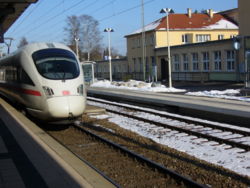
Some train lies are extended past the core network and branch off to serve the following relations:
- from Berlin Hbf to Rostock Hbf (from June 10 2007)
- from Hamburg Hbf to Kiel Hbf
- from Bremen Hbf to Oldenburg Hbf
- from Köln Hbf to Aachen Hbf (continuing to Brüssel Mitte)
- from Koblenz Hbf to Trier Hbf
- from Mannheim Hbf via Kaiserslautern Hbf to Saarbrücken Hbf (continuing to Paris Est from June 10 2007)
- from Stuttgart Hbf via Rottweil – Tuttlingen – Singen to Schaffhausen (continuing Zürich HB)
- from München Hbf to Garmisch-Partenkirchen
- from Nürnberg Hbf via Regensburg Hbf – Plattling nach Passau Hbf (continuing via Linz Hbf to Wien Westbf)
(Also valid for respective other directions)
Bottlenecks
Several lines on the ICE network are highly trafficked, among them:
- from Augsburg Hbf to München Hbf (Bayerische Maximiliansbahn, most frequented line)
- from Dortmund Hbf via Bochum Hbf – Essen Hbf – Duisburg Hbf – Düsseldorf Hbf to Köln Hbf
- from Hamm (Westfalen) via Hagen Hbf – Wuppertal Hbf – Solingen Hbf to Köln Hbf
- from Frankfurt Hbf to Mannheim Hbf (Riedbahn, highest IC/ICE frequency in Germany)
- from Karlsruhe Hbf via Freiburg to Basel SBB
(Also valid for respective other directions)
ICE-Sprinter
The so-called "ICE-Sprinter" trains are extra fast trains between Germany's major cities running in the morning and evening hours. They are tailored for business travellers or long-distance commuters and are marketed by DB as an alternative to domestic flights. Some of the Sprinter services continue as normal ICE services after reaching their destination. Sprinter trains usually depart around 06:00 for morning services and 18:00 for evening services.
A reservation is mandatory on the ICE-Sprinter (currently €11 in 2nd and €16 in 1st class). Additionally to the usual 1st class service (on-seat service, free newspapers like Financial Times Deutschland or Handelsblatt) the 1st class in the Sprinter trains also offers free drinks, an on-seat breakfast or dinner and additional newspapers. In the 2nd class, newspapers are provided in the carriages at no extra cost.
The first Sprinter service was established between Munich and Frankfurt in 1992. Frankfurt-Hamburg followed in 1993 and Cologne-Hamburg in 1994. This service ran as a Metropolitan service between December 1996 and December 2004. In 1998, a Berlin-Frankfurt service was introduced, and a service between Cologne and Stuttgart ran between December 2005 and October 2006. Until December 2006, a morning Sprinter service ran between Frankfurt and Munich (with an intermediate stop at Mannheim), taking 3:25 hours for the journey.
As of December 2006, the individual ICE Sprinter lines are:
| No. | Departure station | Intermediate stops | Destination | Travel time (hh:mm) | Time of day |
|---|---|---|---|---|---|
| 1091 1093 |
Berlin Ostbf | Berlin Hbf, Berlin-Spandau | Frankfurt (Main) Hbf | 3:46 | Morning Evening |
| 1092 1090 |
Frankfurt (Main) Hbf | Berlin-Spandau, Berlin Hbf | Berlin Ostbf | 3:46 | Morning Evening |
| 1071 | Hamburg-Altona | Hamburg Hbf, Hannover Hbf | Frankfurt (Main) Hbf | 3:37 | Morning |
| 1034 | Hamburg-Altona | Hamburg Hbf, Essen Hbf, Duisburg Hbf, Düsseldorf Hbf | Köln Hbf | 3:44 | Morning |
| 1035 | Köln Hbf | Düsseldorf Hbf, Duisburg Hbf, Essen Hbf, Hamburg Hbf | Hamburg-Altona | 3:44 | Morning |
| 1021 | Köln Hbf | Frankfurt (Main) Südbf, Nürnberg Hbf | München Hbf | 3:56 | Morning |
(Source: Deutsche Bahn AG[16])
Line segments abroad
Some ICE trains also run on services abroad - sometimes diverting from their original lines.
- from Duisburg Hbf to Amsterdam CS (The Netherlands)
- from Köln Hbf via Aachen Hbf to Bruxelles-Midi (Belgium, extension toward Oostende to connect to London ferry planned)
- from Saarbrücken Hbf via Baudrecourt nach Paris Est (France)
- from Stuttgart Hbf via Karlsruhe Hbf – Baudrecourt to Paris Est (France)
- from Basel SBB to Interlaken Ost (Switzerland)
- from Basel SBB to Zürich HB (Switzerland)
- from Stuttgart Hbf via Schaffhausen to Zürich HB (Switzerland)
- from München Hbf via Kufstein to Innsbruck Hbf (Austria)
- from München Hbf via Salzburg Hbf – Linz Hbf to Wien Westbf (Austria)
- from Passau Hbf via Linz Hbf to Wien Westbf (Austria)
(Also valid for respective other directions)
Since December 2006, Stuttgart Hbf and Zürich HB are connected with trains running bi-hourly.
The ÖBB in Austria is also using two ICE T trainsets (classified as ÖBB Class 4011 between Wien Westbahnhof, München Hauptbahnhof and Bregenz. They are, however, not using the tilting technology. ÖBB and DB are planning to offer a bi-hourly connection between Wien Westbf and Frankfurt Hbf from December 2007.
Starting in June 2007, ICE 3M trains will be running between Frankfurt Hbf and Paris Est via Saarbrücken. Together with the TGV-operated line between Paris Est, Stuttgart Hbf and München Hbf, this ICE line is part of the "LGV Est européenne", also called "Paris-Ostfrankreich-Süddeutschland" (or POS) for short, a pan-european high-speed line between France and Germany.
Intra-Swiss ICE trains
To avoid empty runs or excess waits, several services exist that operate exclusively inside Switzerland:
- two services from Basel SBB to Interlaken Ost
- one service from Basel SBB to Zürich HB
- one service from Basel SBB to Bern
- one service from Interlaken Ost to Basel SBB
- three services from Zürich HB to Basel SBB
- two services from Bern to Basel SBB
These trains, despite being officially notated as ICEs, are more comparable to a Swiss InterRegio or RegioExpress train, calling at small stations like Möhlin or Sissach. As common in Switzerland, these trains can be used without paying extra for a supplement.
Fare structure
Germany
ICE trains are the highest category (Class A) trains in the fare system of the Deutsche Bahn. Their fares are not calculated on a fixed per-kilometre table as with other trains, but instead have fixed prices for station-to-station connections, depending on a multitude of factors including the railway line category and the general demand on the line. Even on lines where the ICE is not faster than an ordinary IC or EC train (for example Hamburg to Dortmund), an additional surcharge will be levied on the ground that the ICE trains have a higher comfort than the IC/EC trains.
The Netherlands
In the Netherlands, a comparably low € 2 surcharge has to be paid for each trip on the "ICE International". Monthly and annual passes include this surcharge.
Austria
On the intra-Austrian lines (Vienna-Innsbruck-Bregenz, Vienna-Salzburg(-Munich), Vienna-Passau(-Hamburg) and Innsbruck-Kufstein(-Berlin)) no additional fees are charged.
Switzerland
Likewise, the trains running from to Zurich, Interlaken or Chur as well as on the intra-Swiss ICE trains (see above) are free to use without any additional surcharge.
In Switzerland and Austria, a ride on the ICE takes nearly as long as on a domestic train. This is because of the comparably short length of travel and the low speeds in these countries (often no more than 160 km/h, sometimes 200 km/h) when compared to Germany.
Honours
- On October 5, 2006 the Deutsche Post AG released a series of commemorative stamps, among them a stamp picturing an ICE 3, at 55+25 euro cents.
Trivia
- At both ends of ICE-T and ICE3 trains there is a passenger compartment (one end 1st and the other end 2nd class) with a view of the tracks, through a transparent glass window separating the compartment from the driver's cabin. The driver can, however, "frost" the glass at will through the press of a button.
- Bicycles are not permitted on any ICE trains.
- Three specially-built washing-bays for ICE trains exist in Hamburg-Eidelstedt, Frankfurt-Höchst andMünchen Hbf
- In 2006, Lego modelled one of its train sets after the ICE.[17]
References
- ↑ (German) 15 Jahre Hochgeschwindigkeitsverkehr. Deutsche Bahn AG. Retrieved on 2007-02-12.
- ↑ Velaro Concept. Siemens AG. Retrieved on 2007-02-12.
- ↑ (German) Mit dem ICE International nach Belgien. Deutsche Bahn AG. Retrieved on 2007-02-12.
- ↑ (German) Mit der Bahn in die Niederlande. Deutsche Bahn AG. Retrieved on 2007-02-12.
- ↑ ICE 3 Homologation for France in Sight. Deutsche Bahn AG. Retrieved on 2007-02-12.
- ↑ (German) Staff writer (2006). Die Bahn am Ball. Deutsche Bahn AG, p. 96.
- ↑ International breakthrough for Siemens high-speed train technology. Siemens AG (2001-04-03). Retrieved on 2007-02-12.
- ↑ (Russian) Новый международный успех высокоскоростных поездов «Сименс». Siemens AG (2006-03-19). Retrieved on 2007-02-12.
- ↑ (German) Peter Jehle, René Naumann, Rainer Schach (2006). Transrapid und Rad-Schiene-Hochgeschwindigkeitsbahn: Ein gesamtheitlicher Systemvergleich. Springer, p. 20. ISBN 354028334X.
- ↑ (German) Die neuen Wohlfahrtsmarken. Caritasverband Stuttgart e.V.. Retrieved on 2007-02-12.
- ↑ Staff writer (December 2003). "DB is to pull its remaining ICE-TD diesel class 605 trains out of service this month - Germany". International Railway Journal. ISSN 0744-5326.
- ↑ (German) (2000) "Dritte Generation ICE-Triebzüge für DB Reise&Touristik". Elektrische Bahnen, Elektrotechnik im Verkehrswesen (11). ISSN 0013-5437.
- ↑ (German) Wolfgang Maaßen. Frei von Rechten Dritter.... Bund Freischaffender Foto-Designer e.V.. Retrieved on 2007-02-13.
- ↑ (German) Internet im ICE geht in Regelbetrieb über. ZDNet.de (2006-04-07). Retrieved on 2007-02-13.
- ↑ 15.0 15.1 ICE network map. Deutsche Bahn AG. Cite error: Invalid
<ref>tag; name "Netzplan" defined multiple times with different content - ↑ ICE Sprinter, long-distance services. Deutsche Bahn AG. Retrieved on 2007-02-13.
- ↑ LEGO Store - Passenger Train. LEGO. Retrieved on 2007-02-12.
External links
- ICE-Fanpage.de (German) – Private fansite
- railfaneurope.net – Pictures of ICE trains
- www.db.de/hochgeschwindigkeit (German) – DB corporate web site celebrating 15 years of ICE traffic
- fernbahn.de (German) – Coach alignment of all DB long-distance trains
- Long-distance network maps - Network maps of both IC and ICE networks
- ICE network (2007) – PDF map by Deutsche Bahn AG
| Wikimedia Commons has media related to: ICE |
| High-speed trains | |
|---|---|
| Acela Express • Alfa Pendular • AVE • ETR 500 • Eurostar • InterCityExpress • JR-Maglev MLX01 • HST • Korea Train Express • Magnetic levitation trains • Pendolino • Shinkansen • TGV • Thalys • THSR • Transrapid • Treno Alta Velocità • X 2000 |
BR number:
401 |
402 |
403 |
403 alt |
406 |
410 |
411 |
415 |
420 |
421 |
422 |
423 |
424 |
425 |
425 alt |
426 |
426 alt |
427 |
450 |
465 |
485 alt |
490 |
491
ET 11 |
ET 25 |
ET 26 |
ET 27 |
ET 31 |
ET 41 |
ET 51 |
ET 55 |
ET 65 |
ET 82 |
ET 85 |
ET 90 |
ET 91 ("Gläserner Zug")
Battery railcars:
515 |
517 |
ETA 150 |
ETA 176 |
ETA 178 |
ETA 179
S-Bahn EMUs:
Berlin:
475 |
476 |
477 |
480 |
481 |
485 |
ET 125 |
ET 165 |
ET 166 |
ET 167 |
ET 168 |
ET 169 |
ET 170 |
270
Hamburg:
470 |
471 |
472 |
473 |
474 |
ET 99 |
ET 170 |
ET 171
